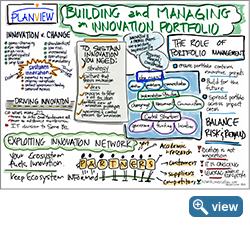
I recently hosted a discussion with Forrester’s, vice president, principal analyst serving CIOs, Chip Gliedman and Planview’s NDP solution market manager Carrie Nauyalis about innovation and portfolio management, and how the two relate. I’ve included an image of the visual notes designed during the live event. Check out this visual reference for the topics and key takeaways about building an innovation portfolio.
We Had a Lively Discussion on Five Topics
- Ce qu'est réellement une innovation et en quoi elle diffère du changement
- The capabilities needed to support sustained innovation across the enterprise
- Driving innovation forward and who typically takes the lead
- How to leverage an innovation network that culls ideas from inside and outside the organization; and last, but not least…
- Comment la gestion de portefeuille peut lier tout cela
My 10 Key Takeaways
- Ideation is not innovation ‒‒ Innovation is a process that spans products/services, processes/operations, markets/business models, and organization/governance.
- Innovation differs from change; innovation:
- Is ongoing, not episodic
- Often has distinct governance and funding
- Implies a greater degree of creativity and risk
- Success metrics are different (often the driving principle is “fail fast, fail cheap”)
- Balancing Risk vs. Reward is key; strive for innovations that drive value
- Exploit the entire ecosystem including employees, customers, suppliers, and more
- Innovation may be “everybody’s job,” but to thrive it is best driven, or at least supported, by a single area.
- Regardless of where innovation “sits” in an organization, the CIO role is going to need to shift to support the growing trend toward more innovation initiatives
- Product Portfolio Management (PPM) helps operationalize innovation throughout the Ideation, Product Planning, Development, and Launch processes. It also helps align projects and other investments with products, and aligns products with brand strategy.
- Be sure to make room in your project portfolios for innovation projects, even smaller efforts that may not have a major impact on current business operations, but help enable business change or growth.
- PMOs should not only help accommodate and support innovation projects (relaxing their methodology and metrics as appropriate), but should encourage and drive the trend. This can also serve to improve the image of the PMO as a bureaucratic bottleneck.
- To drive innovation, you need:
- A strategy for driving and managing innovation
- A culture that fosters innovation
- Ideas! And lots of them!
- Processes to filter and vet the ideas
- A portfolio view of your innovation prototypes
- Governance and control processes for innovation
For more information, listen to the full Webcast discussion Building and Managing an Innovation Portfolio. Meanwhile, I’d like to hear your thoughts. Who drives innovation in your organization? What processes do you have that ensure innovation is considered? What is the maturity level of your innovation program and what challenges are you facing? And lastly, what do you find stifles innovation in your organization?





